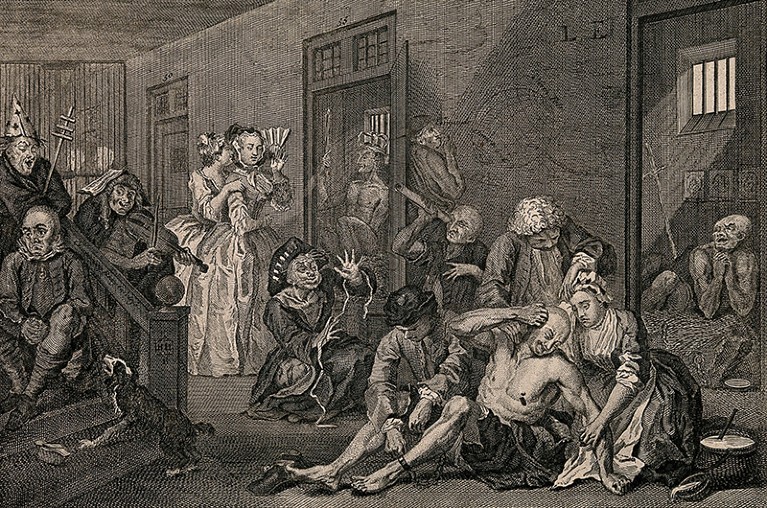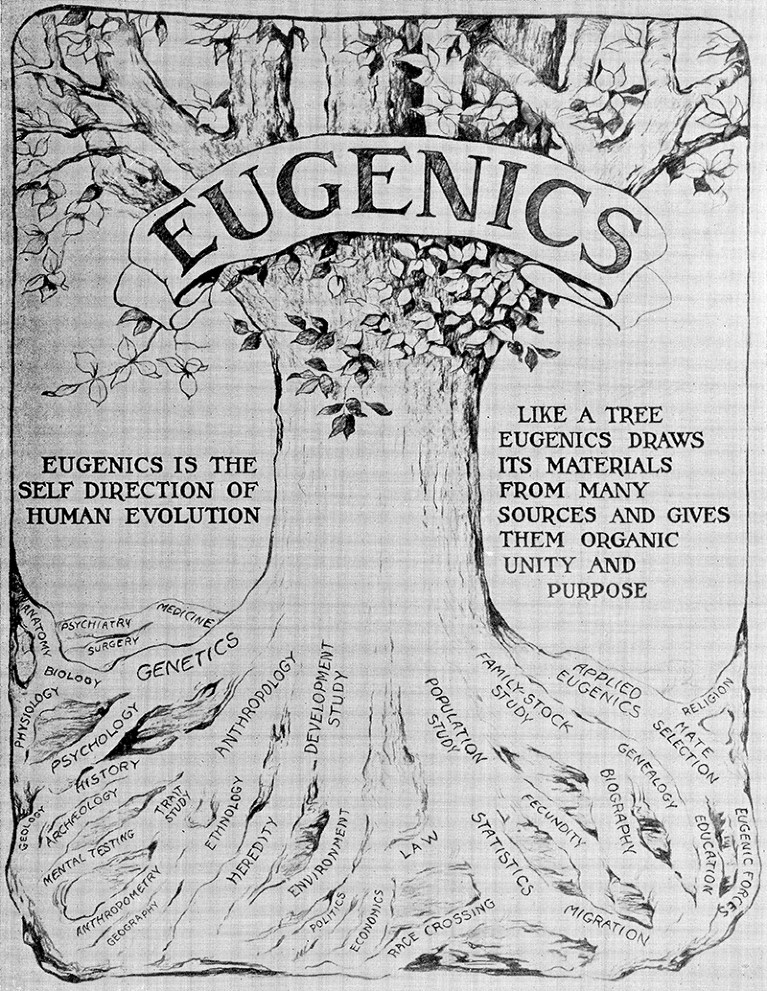
The scene in Bethlem asylum, London, in William Hogarth’s 1735 A Rake’s Progress.Credit: Wellcome Coll.
Genetics in the Madhouse: The Unknown History of Human Heredity Theodore M. Porter Princeton University Press (2018)
Who founded genetics? The line-up usually numbers four. William Bateson and Wilhelm Johannsen coined the terms genetics and gene, respectively, at the turn of the twentieth century. In 1910, Thomas Hunt Morgan began showing genetics at work in fruit flies (see E. Callaway Nature 516, 169; 2014). The runaway favourite is generally Gregor Mendel, who, in the mid-nineteenth century, crossbred pea plants to discover the basic rules of heredity.
Bosh, says historian Theodore Porter. These works are not the fount of genetics, but a rill distracting us from a much darker source: the statistical study of heredity in asylums for people with mental illnesses in late-eighteenth- and early-nineteenth-century Britain, wider Europe and the United States. There, “amid the moans, stench, and unruly despair of mostly hidden places where data were recorded, combined, and grouped into tables and graphs”, the first systematic theory of mental illness as hereditary emerged.
For more than 200 years, Porter argues in Genetics in the Madhouse, we have failed to recognize this wellspring of genetics — and thus to fully understand this discipline, which still dominates many individual and societal responses to mental illness and diversity.
The study of heredity emerged, Porter argues, not as a science drawn to statistics, but as an international endeavour to mine data for associations to explain mental illness. Few recall most of the discipline’s early leaders, such as French psychiatrist, or ‘alienist’, Étienne Esquirol; and physician John Thurnam, who made the York Retreat in England a “model of statistical recording”. Better-known figures, such as statistician Karl Pearson and zoologist Charles Davenport — both ardent eugenicists — come later.
Inevitably, study methods changed over time. The early handwritten correlation tables and pedigrees of patients gave way to more elaborate statistical tools, genetic theory and today’s massive gene-association studies. Yet the imperatives and assumptions of that scattered early network of alienists remain intact in the big-data genomics of precision medicine, asserts Porter. And whether applied in 1820 or 2018, this approach too readily elevates biology over culture and statistics over context — and opens the door to eugenics.

An excerpt from the papers of the Third International Congress of Eugenics, held at the American Museum of Natural History in New York City in 1932.Credit: Wellcome Coll.
As Porter notes, alert readers might ask how a force so crucial in the birth of genetics remained hidden. His answer distills to three arguments. First, after the Second World War, geneticists took pains to distance themselves from asylum science and eugenics, and historians left this largely unquestioned. Second, the system’s influence is partly obscured by its cruelty and neglect; we must look past those to see its determination to use statistics to identify people as ‘defective’. Third, the asylum network was easy to overlook because it was loose and decentralized.
It started with fine intentions. Many asylum founders of the late eighteenth and early nineteenth centuries hoped to cure people of mental illness through a humane, psychosocial “moral therapy”. These included the York Retreat’s founder, William Tuke, and Esquirol and his mentor, Phillipe Pinel.
These asylums and their records soon received transformative scrutiny. In 1788, King George III of Britain, who since his coronation had sometimes displayed symptoms suggesting psychosis, had an extreme episode. Understanding mental illness became a national-security issue. The alienists’ assessment, bolstered by physician William Black’s “original, useful, and authentick” statistics from London’s Bethlem asylum, gave the government leverage to replace the king with a regent — his son, later King George IV.
This much-publicized process spurred a decades-long growth in asylums run by the “numerical method”, and the use of national censuses to measure what seemed an epidemic of ‘insanity’. At the time, this baggy term encompassed a range of behaviours deemed extreme. Similar developments elsewhere helped spread this methodology across most of the developed Western world.
From London and Paris to Schussenried, Germany, and Worcester, Massachusetts, asylums grew and new ones sprouted. Knitting them together was an active system of correspondence, travel, conferences and publications such as the American Journal of Insanity and the Allgemeine Zeitschrift für Psychiatrie.
At first, asylums claimed absurdly high ‘cure’ rates. Reports of 50% were routine. The Connecticut Retreat claimed 91.6% four years in a row. By the mid-nineteenth century, however, asylum directors realized that they could simply say, as some big-data psychiatric geneticists do now, that although a cure seems distant, statistical patterns discovered in ever-larger study populations will one day reveal a cause — and a cure will follow. Funders bought it. Asylum science grew apace.
Eventually, having eliminated religious fervour, heartbreak, financial strain and masturbation as causes for mental illness, alienists fixed on the only pattern left: patients’ pedigrees. Heredity was “the one great cause … the cause of causes”, as French surgeon Ulysse Trélat proclaimed in 1856.
Thus asylum scientists unwittingly laid a path to disaster. For if mental illness boiled down to heredity, the final cure — if you insisted on imposing one — became both obvious and unspeakable.
Porter’s chapters, with titles smacking of gothic Victorian novels, trace the long walk to corruption. ‘Narratives of mad despair accumulate as information’ gives way to ‘German doctors organize data to turn the tables on degeneration’, a foretaste of horror. The final chapter, ‘Psychiatric geneticists create colossal databases, some with horrifying purposes, 1920–1939’, sees eugenics deployed en masse. After the 1927 Supreme Court decision Buck v. Bell, US programmes forced sterilization on tens of thousands of people deemed mentally deficient. The Nazis built on that example in the 1930s by sterilizing some 400,000 Germans labelled hereditarily ‘defective’. In 1940, they launched their wider genocidal programme by gathering more than 10,000 people from asylums all over southern Germany and gassing them at Grafeneck Castle.
The story of the era, Porter insists, is not one “of isolated failings by a few bad scientists”. Every genetic insight along the way was sucked into the stream. Many geneticists and alienists had invested too heavily to stop. Others had the task brought to them. It was not by chance that the Holocaust found its first victims in asylums, which also housed the rosters, records and rationale that doomed them.
This matters for many reasons, according to Porter, the most immediate being the elemental links between this history and contemporary study of heredity. As Porter exposes strand after strand of connection, he draws sobering parallels between the motives, methods, obsessions and promises of bygone asylum directors, and those of the enormous human-genomics institutes that now enjoy unprecedented funding and power.
To Porter, these connections are roots, and today’s genomics industry the tree. “Sold with a promise to find the genes for talents, diseases, and every kind of personal characteristic”, he writes, genetics has returned to “the tradition of amassing, ordering, and depicting data of biological inheritance” that started more than two centuries ago, in squalor.
Some will reject this idea ferociously. But I suspect this bold, dauntingly well-documented book will prove difficult to dismiss.

 When eugenics became law
When eugenics became law
 The truth about Hans Asperger’s Nazi collusion
The truth about Hans Asperger’s Nazi collusion
 Nature still battles nurture in the haunting world of social genomics
Nature still battles nurture in the haunting world of social genomics
 The dispossessed
The dispossessed
 America the traumatized
America the traumatized







